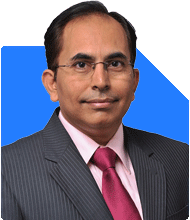Ramalingam Kalirajan |10881 Answers |Ask -Follow
Mutual Funds, Financial Planning Expert - Answered on Jun 06, 2024
He has an MBA in finance from the University of Madras and is a certified financial planner.
He is the director and chief financial planner at Holistic Investment, a Chennai-based firm that offers financial planning and wealth management advice.... more

Dear Sir I have earlier asked for corpus planning for retiring now at 55 years age. I have a monthly expenditure of 75k/month. My corpus is around 4 cr. Will this be sufficient and how do I deploy them.
Congratulations on accumulating a corpus of Rs 4 crores. This is a significant achievement and a solid foundation for your retirement. At 55 years old, with a monthly expenditure of Rs 75,000, it’s essential to carefully plan your finances to ensure they last throughout your retirement.
Estimating Retirement Expenses
Understanding Your Monthly Expenditure
Your current monthly expenditure is Rs 75,000. To calculate your annual expenses, multiply this by 12, resulting in Rs 9 lakhs per year. It's crucial to consider inflation, typically around 6% per year in India, which will increase your expenses over time.
Projecting Future Expenses
Using an inflation rate of 6%, your annual expenses will rise. For instance, in 10 years, your annual expenditure will be approximately Rs 16.1 lakhs. Planning for at least 30 years of retirement, your expenses will significantly increase due to inflation.
Creating a Sustainable Withdrawal Plan
Safe Withdrawal Rate
A widely recommended strategy is the 4% rule, which suggests withdrawing 4% of your corpus annually. This approach aims to make your savings last for 30 years. However, considering inflation, a more conservative withdrawal rate might be prudent.
Calculating Annual Withdrawals
With a corpus of Rs 4 crores, a 4% annual withdrawal equates to Rs 16 lakhs per year. This comfortably covers your current annual expenses of Rs 9 lakhs, with room to account for future inflation.
Investment Strategy for Retirement
Diversifying Your Portfolio
Diversification is crucial to manage risk and ensure a steady income stream. Your portfolio should balance growth and income-generating investments.
Equity Mutual Funds: Allocate around 40% of your corpus to equity mutual funds for growth. These funds can help combat inflation and provide higher returns over the long term.
Debt Mutual Funds: Allocate about 40% to debt mutual funds. These funds offer stability and regular income, reducing overall portfolio risk.
Fixed Deposits and Bonds: Invest 20% in fixed deposits and bonds for guaranteed returns and capital preservation.
Generating Regular Income with SWP
A Systematic Withdrawal Plan (SWP) allows you to withdraw a fixed amount regularly from your mutual fund investments. This method provides a steady income stream while keeping your principal invested, potentially growing over time.
How SWP Works: You invest a lump sum in a mutual fund. Then, you set up an SWP to withdraw a fixed amount monthly. The remaining corpus continues to earn returns, balancing withdrawals and potential growth.
Benefits of SWP:
Steady Cash Flow: Provides a regular, predictable income stream.
Tax Efficiency: Only the capital gains part of your withdrawal is taxed, often resulting in lower tax liability compared to other investment options.
Flexibility: You can adjust the withdrawal amount or frequency based on your needs.
Implementing SWP:
Initial Investment: Start with a substantial initial investment in a balanced or equity-oriented mutual fund.
Withdrawal Amount: Determine a reasonable monthly withdrawal amount that aligns with your expenses, considering inflation and fund performance.
Review and Adjust: Regularly review the performance of your mutual fund and adjust the SWP if necessary to ensure sustainability.
Managing Risk and Ensuring Longevity
Rebalancing Your Portfolio
Regularly review and rebalance your portfolio to maintain the desired asset allocation. This helps manage risk and ensures your investments align with your financial goals.
Emergency Fund
Maintain an emergency fund covering at least 6 months of expenses. This fund should be easily accessible and kept in a high-interest savings account or liquid fund.
Planning for Healthcare
Health Insurance
Ensure you have adequate health insurance coverage. Medical expenses can be significant in retirement, and a robust health insurance policy will protect your savings.
Contingency Planning
Set aside a portion of your corpus specifically for healthcare and unexpected expenses. This ensures you’re prepared for any medical emergencies or unforeseen costs.
Tax Planning
Tax-Efficient Investments
Choose tax-efficient investment options like SCSS, and specific mutual funds to minimize your tax liability. Understanding the tax implications of your investments helps maximize your net returns.
Annual Tax Review
Conduct an annual review of your tax situation. This helps in optimizing your investment strategy and ensuring you make the most of available tax benefits.
Estate Planning
Will and Nomination
Prepare a will and ensure all your investments have the correct nominations. This ensures a smooth transfer of your assets to your heirs.
Power of Attorney
Consider appointing a trusted person as your power of attorney. This person can manage your financial affairs if you become unable to do so.
Reviewing and Adjusting Your Plan
Regular Financial Review
Review your financial plan regularly, at least once a year. This ensures your strategy remains aligned with your goals and market conditions.
Consulting a Certified Financial Planner
Consider consulting a Certified Financial Planner (CFP) for personalized advice. A CFP can help tailor your investment strategy to your specific needs and circumstances.
Scenario Analysis
Best-Case Scenario
In the best-case scenario, your investments perform well, and you withdraw a sustainable amount each year. Your corpus grows over time, even accounting for inflation and withdrawals.
Worst-Case Scenario
In the worst-case scenario, market downturns occur, or unexpected expenses arise. Your careful planning, diversification, and emergency fund will help mitigate these risks and ensure financial stability.
Long-Term Sustainability
Adjusting Withdrawals
If needed, adjust your withdrawal rate based on market performance and your expenses. Flexibility in withdrawals helps sustain your corpus over the long term.
Staying Informed
Stay informed about market trends, economic conditions, and changes in financial products. This knowledge helps make informed decisions and adapt your strategy as needed.
Considering Your Lifestyle
Enjoying Retirement
Ensure your financial plan allows you to enjoy your retirement. Allocate funds for travel, hobbies, and other activities that enhance your quality of life.
Social Security and Benefits
Check for any social security benefits or pensions you may be entitled to. These can supplement your income and reduce the pressure on your corpus.
Summarizing Your Plan
To summarize, your Rs 4 crore corpus can sustain your retirement if managed wisely. Focus on diversifying your investments, maintaining an emergency fund, and regularly reviewing your plan. Ensure you have adequate health insurance and consider tax-efficient investments. Flexibility and informed decision-making are key to a secure and enjoyable retirement.
Best Regards,
K. Ramalingam, MBA, CFP,
Chief Financial Planner,
www.holisticinvestment.in
You may like to see similar questions and answers below
Ramalingam Kalirajan |10881 Answers |Ask -Follow
Mutual Funds, Financial Planning Expert - Answered on Apr 30, 2024
Ramalingam Kalirajan |10881 Answers |Ask -Follow
Mutual Funds, Financial Planning Expert - Answered on Jul 15, 2024
Ramalingam Kalirajan |10881 Answers |Ask -Follow
Mutual Funds, Financial Planning Expert - Answered on Sep 21, 2024
Janak Patel |71 Answers |Ask -Follow
MF, PF Expert - Answered on Jun 05, 2025
Dr Dipankar Dutta |1841 Answers |Ask -Follow
Tech Careers and Skill Development Expert - Answered on Dec 14, 2025
Nayagam P P |10854 Answers |Ask -Follow
Career Counsellor - Answered on Dec 14, 2025
Radheshyam Zanwar |6744 Answers |Ask -Follow
MHT-CET, IIT-JEE, NEET-UG Expert - Answered on Dec 14, 2025
Radheshyam Zanwar |6744 Answers |Ask -Follow
MHT-CET, IIT-JEE, NEET-UG Expert - Answered on Dec 14, 2025
Dr Dipankar Dutta |1841 Answers |Ask -Follow
Tech Careers and Skill Development Expert - Answered on Dec 14, 2025
Dr Dipankar Dutta |1841 Answers |Ask -Follow
Tech Careers and Skill Development Expert - Answered on Dec 13, 2025
Dr Dipankar Dutta |1841 Answers |Ask -Follow
Tech Careers and Skill Development Expert - Answered on Dec 13, 2025
Mayank Chandel |2575 Answers |Ask -Follow
IIT-JEE, NEET-UG, SAT, CLAT, CA, CS Exam Expert - Answered on Dec 13, 2025
Radheshyam Zanwar |6744 Answers |Ask -Follow
MHT-CET, IIT-JEE, NEET-UG Expert - Answered on Dec 13, 2025
Mayank Chandel |2575 Answers |Ask -Follow
IIT-JEE, NEET-UG, SAT, CLAT, CA, CS Exam Expert - Answered on Dec 13, 2025






















